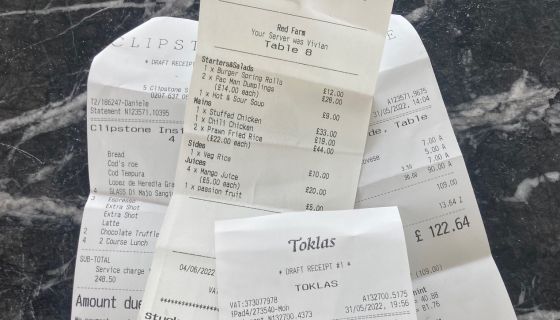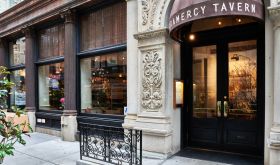The restaurant bill, or check, a reminder of all that you have eaten and drunk, remains the only constant piece of paper in the business.
The word ‘bill’ may have a charming origin, deriving from the French phrase billet doux when the total owed was written on the back of a paper menu. Today, however, legal constraints dictate that every bill presented in the UK must include the following information, listed here by Nicholas Newman of accountants Harris & Trotter:
1 – that this is an invoice
2 – a unique invoice number
3 – the name and address of the restaurant
4 – a description of the goods sold, i e what you have eaten and drunk
5 – the date that these were supplied
6 – an invoice date
7 – a breakdown of the individual goods enjoyed
8 – the total amount payable, and
9 – (if the restaurant is VAT-registered) the VAT number.
These requirements in turn dictate why so many of today’s bills look the same. They are printed on a printer linked to an EPOS (electronic point of sale) system. Sometimes they are enclosed in an embossed folder or clipped together with the restaurant’s business card, and then handed over to you, the customer. I would like to add that this is something that takes place automatically but too often I have to ask for my copy of the bill.
It is when the bill is presented that you, the customer, are in the strongest position to complain if anything has gone wrong.
It is foolish bravado for a customer to start waving their credit card around at this stage, or to forget to check the total, or to press a credit card into the hand of the waiting staff without even glancing at the bill. All these are ploys which actually reduce your rights. Once you have paid the total, it is far more difficult to rectify the situation, so presentation of the bill or check is the moment when you may justifiably complain. Justifiable complaints include your opinion that there has been something wrong with the food served; if the waiter has been impolite to someone at your table; or if your table was served less than what has been specified on your bill.
The chances of this happening – or of your being charged for food that you have not eaten – has dramatically reduced with the gradual removal of the human factor. Today most restaurants will have chosen an EPOS system – Lightspeed, Trevalis and Squirrel are three of the most common – that allows the waiter to establish a table in the system, to send that table’s food order to the kitchen and its drinks order to the bar, to add to it as and when necessary and, finally, to establish the bill and to print it off.
Today, reservation systems such as OpenTable and Resy are invariably linked to the EPOS system, providing the restaurateur with valuable information about previous spending habits and which dishes you particularly enjoyed, allowing them to respond suitably to your next visit.
Presentation of the bill, which also allows the restaurant to signal that your allotted time is up, is also the moment that provides the restaurant with two opportunities to soften the blow. The first and longest-established practice is the offer of petits fours or some kind of sweetmeat that will leave your guests with a more pleasant taste than that of the bill. The second, and far more recent, is the custom of a growing number of restaurateurs to add a well-meaning message to the bill. At Cojean, the French cafe by St Paul’s cathedral in the City of London, the bill for a coffee and a canelé revealed that 10% of the company’s profits go to a charitable foundation. At the Indian restaurants of Dishoom, the message is that every penny of the service charge is shared equally between all the staff.
The service charge is calculated and in most of Europe is charged automatically although it is often described as ‘optional’, wording that exempts the restaurant from the taxes that would have to be paid if it were not thus described. This amount can be disputed and not paid if you, the customer, can prove sufficient grounds. The chip and pin system has effectively ruled out the nefarious practice of incorporating the service charge in the total and then tricking the customer into tipping on top of it.
One final factor that results from the fact that most bills today are computer-generated is that the restaurant can easily divide the bill by the number of people who agree to pay it, avoiding squabbles and inaccurate arithmetic. A recent dinner bill for four that totalled a not-easily-divisible £454.51 was thoughtfully broken down under the heading ‘division hint’ into halves, thirds and quarters. This seems to be an increasingly appreciated option.
Cash and cheques have virtually disappeared as methods of payment, as has the insensitive assumption that the bill must be presented to any man at the table.
Bills may be more functional and less open to human error than they once were, although with rising food inflation everywhere, the totals will presumably only increase.














